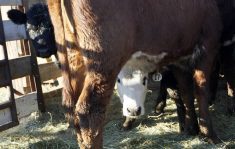Three years of drought have forced Alberta’s third largest municipality
to declare itself an agricultural disaster area.
Taking such drastic action may be the best way for Cypress County to
capture the attention of government, said county councillor LeRay Pahl.
He ranches near Canadian Forces Base Suffield.
“It’s pretty serious down here. Management doesn’t make any
difference,” he said.
Pahl sent most of his cows to northern Saskatchewan last year and any
animal older than six years has been sold. Last summer he grazed 27
Read Also

Saskatchewan dairy farm breeds international champion
A Saskatchewan bred cow made history at the 2025 World Dairy Expo in Madison, Wisconsin, when she was named grand champion in the five-year-old Holstein class.
cows on 17,000 acres of pasture and still had to haul feed to them.
Hay and water are in short supply across the south. The only water in
most dugouts is a thin layer of frost at the bottom.
Southeastern Alberta community pastures are likely to remain closed
this year.
The county wants the province to trigger several aid packages,
including an acreage payment similar to last year, when the province
paid pasture holders $4 per acre.
“An acreage payment would be a tremendous benefit to everybody,” Pahl
said.
The county wants the provincial government to renew its water pumping
program for a longer term beyond Nov. 30.
The program helps farmers develop on-farm water supplies with new
wells, dugouts and pipeline projects. The water plan pays one-third of
development costs, to a maximum of $5,000 per farm.
Ranchers also want a tax deferral on breeding stock for at least three
years. Most people need the break because few can afford to replace an
entire cow herd in one year.
Delvin Stuber at the Medicine Hat Feeding Co. auction market is
watching the cow market. While a large number of cows already went
through the ring because their calves died during March’s brutally cold
calving season, he predicts more will follow.
“If we don’t get any moisture, more cows will be sold in the next two
weeks,” he said.
“It’s been dry for three years. We never even got green last year.”
Buyers from northern Alberta, eastern Saskatchewan and Manitoba have
been taking the females.
Irrigation water has also been severely curtailed as irrigation
districts wait for reservoirs to capture limited spring runoff before
turning on the water.
Weather records indicate this stretch of drought is the worst since
records began in 1884.
The county also hopes its action draws support from surrounding
municipalities to show Ottawa that help is needed immediately.
“We can’t wait until August to make some decisions,” he said.
This situation justifies comprehensive farm safety nets to address
serious natural disasters, similar to programs available in the United
States, said Canadian Alliance MP Monte Solberg. His Medicine Hat
riding runs from the Saskatchewan border to Bassano and south of the
Red Deer River to Montana. The entire area has been dry for three years.
“People in rural areas begin to question whether the government
realizes the situation they are in,” said Solberg. “They have the sense
that they don’t count when it comes to making decisions around the
cabinet table.”
While the area has a rich oil and gas industry, agriculture remains its
economic backbone.
Drought not only dries up the farms and ranches but diminishes smaller
communities. As conditions worsen, Solberg fears people will abandon
the area.
The province has already launched a permanent drought contingency
program.
“Every year we are dealing with drought somewhere in the province,”
said Alberta Agriculture’s Lloyd Andruchow.
However, it is too early to activate some of the drought relief plans.
“The science will dictate if you are in a drought alert or actual
drought.”
Information is still being compiled from soil moisture tests and
weather monitoring stations. A soil moisture report is expected by the
end of April.
The program provides money and equipment for delivering water, weather
stations and possible acreage payments.
Agriculture minister Shirley McClellan told the provincial legislature
April 17 that farmers will not be abandoned.
“It would be very unusual to consider a drought in April …. However
we do know in some regions of the province it will take more than one
year to recover from these conditions,” she said during question period.
Large tracts of Saskatchewan face an equally dismal spring.
“The biggest concern right now is our livestock guys. There is a lot of
concern for pasture and hayland and water supplies,” said Terry
Karwandy of Saskatchewan Agriculture.
The northern grain belt and southwestern Saskatchewan are in poor
moisture condition. The extent will not be known until soil moisture
tests are taken at the end of April.
Some areas have received spring snows but it was not enough to
replenish subsoil moisture.
In the North Battleford area, for example, moisture conditions were 38
percent of normal. An early April snowstorm brought up moisture levels
to 52 percent of normal, said Karwandy.















